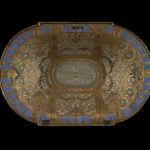9825 A LARGE GILTWOOD AND BLUE PAINTED NEOCLASSICAL LAYETTE IN THE MANNER OF GIUSEPPE BOZANIGO Possibly Turin Or Milan. Circa 1785. Measurements: Height: 14 3/4″ (37.5 cm) Width: 30″ (76.2 cm) Depth: 19 1/4″ (49 cm)

Research
Of giltwood with blue painted decoration. The casket surmounted by a domed lid with foliate and fluted carving with a carved tier laurel wreath and pea molded edge. The underside of the lid is decorated in the manner of a neoclassical ceiling design. The body fronted by a protruding fluted plaque with bowed ends decorated with stiff leaf carving. The lower edge with continuous carved knulling. The replaced feet of outswept pattern are fluted and carved with Greek key motif. Painting and gilding refreshed by a previous owner.
Marks:
Bears a paper label:
William 2nd HEIR LOOM. No. 5?2 C.T.
Stamped:
A.W. L1433
Provenance:
Lord & Lady Iliffe of Basildon Park.
The celebrated Piedmontese sculptor, furniture maker and ornamentalist Giuseppe Maria Bonzanigo (1745-1820) was born into a family of woodcarvers in Aste. By 1773 he had settled in Turin where he was engaged at the Savoy court. His first recorded commission there was for picture frames for portraits in the Royal apartments.
The Royal account books reveal that over the following twenty years he supplied an array of objects including chairs, stools, sofas, mirrors, screens, beds and panels for the Palazzo Reale in Turin as well for the Savoy residences at Moncalieri, Rivoli, Stupinigi, Venaria and Govone. In 1787 Vittorio Amadeo III, acknowledging his ‘singular mastery’, appointed him official woodcarver to the Crown.
Bonzanigo’s distinctively crisp and elaborate carved work is a striking departure from the traditional school of Franco-Piedmontese inlay and marquetry. The effect created by his pieces was most stunningly demonstrated when he was commissioned to create entire rooms such as the state rooms of the Queen and King at Stupinigi.
The function of this casket was to serve as a layette, a collection of clothing and appurtenances for a newborn, and was likely a commission for an infant of a royal or important family due to the quality of the sumptuous carving and gilding. The carving of the layette illustrates the shift toward neoclassicism in late 18th century decor in its architectural form and foliate motifs, while the blue and gilt coloring and classical decoration, typical of Bonzanigo’s work, conforms to the ornamentation employed in Piedmontese region of Italy at this time.


Comments are closed.